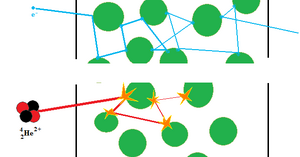LET
Linear energy transfer (LET, radiation energy transfer over distance) is a quantity typical for individual types of ionizing radiation. It gives the energy that a particle or photon imparts, relative to the distance it penetrates the surrounding medium. The overall trajectory of the particle or photon does not matter. The basic unit of LET is J/m. But the LET values are very small, so keV/μm is more often used.
LET value[edit | edit source]
It is determined by the energy of the radiation entering the environment and its ability to interact with the environment.
- LET increases with the charge of the particle, the trajectory is affected by the attractive forces of the surrounding charges. Also, as the particle size increases, the LET increases, larger particles more often "bumping" into the surroundings.
- Lower LET shows indirectly ionizing radiation' (neutrons, γ-rays, X-rays). The relationship with size is similar, smaller passes better.
The unequal ability of individual types of radiation to transfer energy to the environment affects the so-called effective H dose. This is calculated as the original dose D [Gy] times the radiation quality factor Q. The resulting unit is Sievert [Sv].
- For γ, β and X-ray radiation, Q=1;
- for α radiation with Q=20.
Example[edit | edit source]
Scheme of LET α particle and β- particle. Although α radiation has more energy, it quickly transfers it to the environment → high LET. β- particle reflects more easily, transmits less energy at the same distance → small LET.
Links[edit | edit source]
Related Articles[edit | edit source]
References[edit | edit source]
- BENEŠ, Jiří, Pravoslav STRÁNSKÝ a František VÍTEK. Základy lékařské biofyziky : Basisübungen für alle Sportarten. 2. vydání. Praha : Karolinum, 2007. 201 s. ISBN 978-80-246-1386-4.

